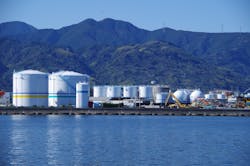A flowmeter that measures velocity is designed to measure the flow of a gas whose temperature is controlled within 3°C of its setpoint of 27°C. What is the approximate flow error resulting from the expected temperature fluctuation?
A. ±1 percent
B. ±3 percent
C. ±5 percent
D. ±10 percent
The output of a flowmeter that measures fluid velocity will increase (or decrease) linearly as the size of the fluid increases (or decreases). Therefore, the effect of a 3°C temperature change on the flow measurement depends upon the amount by which the gas volume changes.
One might be tempted to select Answer D because the temperature change is almost 10 percent (27°C to 30°C). However, the change in size of the gas is related to the change in its absolute temperature, which is relative to the temperature at which all heat is removed — not relative to the freezing and boiling points of water.
The setpoint of 27°C was, not coincidentally, chosen for this application because it approximates room temperature and corresponds to an absolute temperature of 300 Kelvin. A 3°C temperature change represents a 1 percent change in absolute temperature and a 1 percent volume change (Charles’ Law), so Answer A is correct.
The answer may seem academic but a deeper understanding reveals that even relatively small temperature variations under nonextreme operating conditions can have a significant effect on flowmeter performance, especially since flowmeter accuracy specifications are often better than 1 percent of rate. The effect under actual conditions can be dramatically larger.
Additional complicating factors
Flowmeters that do not measure linearly as a function of velocity will exhibit different relationships. For example, a differential pressure flowmeter will exhibit approximately one-half the error as compared to a linear flowmeter. In contrast, thermal flowmeters should not be affected by temperature variations.
David W. Spitzer is a principal at Spitzer and Boyes, LLC, which offers engineering, focused market research, writing/editing white papers, strategic marketing consulting, distribution consulting, seminars and expert witness services for manufacturing and automation companies. Spitzer has written more than 400 technical articles and 10 books about flow measurement, instrumentation and process control. He can be reached at 845-623-1830 or via spitzerandboyes.com.



